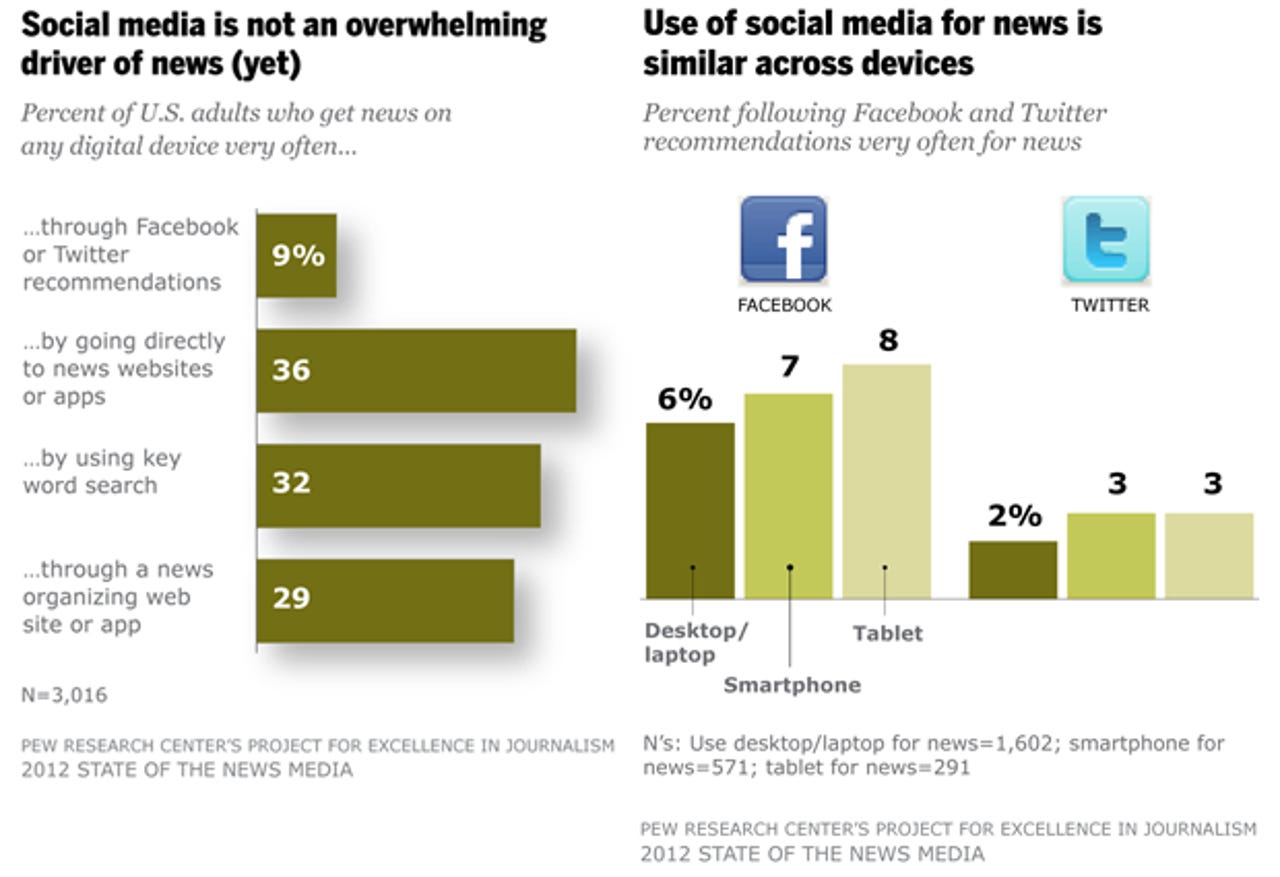Americans choose Facebook over Twitter for news

Currently, Facebook and, to a lesser extent, Twitter, dominate the intersection of social media and news. A new Project for Excellence in Journalism (PEJ) report released as part of The State of the News Media 2012 looks at news consumption and habits on different digital devices. Overall, the survey confirms that Facebook and Twitter are now pathways to news, but their role may not be as large as some have suggested: they are used as supplements to news sources, not as replacements.
More than twice as many digital news consumers follow news recommendations from Facebook than follow them from Twitter. This remains consistent across different digital devices (computers, smartphones, and tablets). 7 percent of Americans get news from Facebook very often, compared with 3 percent who do so via Twitter. Another 19 percent say they get recommendations via Facebook somewhat often, and 4 percent via Twitter somewhat often.
Unsurprisingly, the populations overlap. 82 percent of those who ever get some news via Twitter recommendations also get some news via Facebook recommendations, and 40 percent do so very often or somewhat often. Facebook users, however, are much less likely to be on Twitter than the other way around. Just 27 percent of Facebook news followers also get news via Twitter, with 11 percent doing so somewhat or very often. Overall, 13 percent of digital news consumers follow news recommendations on both Facebook and Twitter – but fewer than 4 percent do so regularly.
On the flipside, 56 percent of those who get news recommendations from Facebook say they think they would have gotten that news from somewhere else. Only 34 percent said they would not have seen it otherwise. Twitter users are meanwhile nearly split between the sense that they would get this news elsewhere (43 percent) and that they would not (39 percent).
Furthermore, 76 percent of Twitter new followers own a smartphone compared to 67 percent of Facebook news followers and 60 percent of digital news consumers overall. It follows that Twitter users are also more likely to get news on their smartphone: 64 percent versus 47 percent for Facebook users and 30 percent for all mobile news consumers. The same goes for tablets: 42 percent (Twitter) versus 30 percent (Facebook) and 26 percent (digital news consumers overall) own one and 31 percent (Twitter) versus 20 percent (Facebook and digital news consumers overall) get news there.
Here are the study's three main findings for the two services:
- Americans are far more likely to get digital news by going directly to a news organization's website or app than by following social media links. Just 9 percent of U.S. adults say they follow news recommendations from Facebook or Twitter "very often" on any digital device — compared with 36 percent who say the same about directly going to a news organization's site or app, 32 percent who access news through search, and 29 percent who use news organizing sites like Topix or Flipboard.
- Even so, social media are an increasingly important driver of news, according to traffic data. According to PEJ's analysis of traffic data from Hitwise, 9 percent of traffic to news sites now comes from Facebook, Twitter, and smaller social media sites. That is up by more than half since 2009. The percentage coming from search engines, meanwhile, has dropped to 21 percent of news site traffic, from 23 percent in 2009.
- Facebook users follow news links shared by family and friends; Twitter users follow links from a range of sources. Fully 70 percent of Facebook news consumers get most of their story links from friends and family. Just 13 percent say most links that they follow come from news organizations. On Twitter, however, the mix is more even: 36 percent say most of the links they follow come from friends and family, 27 percent say most come from news organizations, and 18 percent mostly follow links from non-news entities such as think tanks.
The findings are based on three surveys conducted by Princeton Survey Research Associates International in January 2012 (12-15, 19-22, and 26-29). 3,016 U.S. adults (18 years of age or older) were surveyed over the telephone (1,809 landline and 1,207 cellphone). Statistical results are weighed to correct known demographic discrepancies, and the sampling error for the complete set of weighed data is ±2.2 percentage points.
See also:
